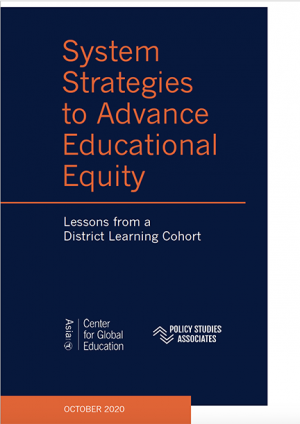
March 2, 2021 | By Christina Russell and Derek Riley
During the 2019-20 school year, 10 districts from across the United States—including nine districts from the League of Innovative Schools—joined a learning cohort, convened by the Center for Global Education at Asia Society and Digital Promise, to explore this question. Leaders shared strategies and learned from the Toronto District School Board, where leadership has explicitly centered and invested in equity. They recently reflected on their learning, and six strategies for advancing educational equity emerged.

“System Strategies to Advance Educational Equity” describes the actions and strategies that TDSB and the learning-cohort districts are taking to translate their equity commitments to systemwide action.
Equity leaders must be prepared to be both courageous and vulnerable in articulating their vision. Reviewing district policies and procedures through an equity lens can lead to pushback, and even anger, as longstanding systems of privilege and power are questioned. An assistant superintendent in the School District of Palm Beach County (Florida) noted that changing the culture of school systems “requires a level of humanity, and humility, and empathy, and partnership, and trust.” The importance of reimagining education through an equity lens has been amplified through the twin pandemics of COVID-19 and racial injustice of 2020, accelerating the urgency for districts. According to Dr. Daryl Diamond, director of innovative learning for the Broward County (Florida) Public Schools, “That’s what I’m starting to hear now in the national conversations. If we want to live in a society where everyone can flourish, what role does the school system play?”
Responsibility for equity cannot live within a single office or position. Change will occur only when there is commitment to equity throughout a district, starting with the school board. The Springfield (Missouri) Public Schools board adopted a strategic plan that includes a goal focused on equity and diversity, creating accountability for equity and expressing the value of equity work for the board and community. According to Superintendent John Jungmann, “There are policy changes that the board will have to review and have public conversations about that are certainly probably outside the comfort zone of a rural Southwest Missouri region. … It’s not going to be easy to do, but it’s the right thing to do and the board’s committed to it and we’re not afraid to say that we need to modify policies.”
Ideas alone will not lead to change. Equity tools can ensure that equity is infused throughout a district and guides decision-making. For example, the Richland (South Carolina) School District Two is developing a framework that will be used to apply an “equity test or equity lens” to decisions in the district. A senior leader described an ongoing effort to comprehensively review district and board policies to ensure they do not “create some sort of systematic or systemic obstacle or barrier for our students, regardless of their race, gender, creed, or religion, or whatever it may be.”
Creating an equitable school district requires new capacities and supports for leaders and educators. Portland (Oregon) Public Schools has developed a Racial Equity and Social Justice framework and, with support from the Leadership Academy, is training district leaders to identify bias- and deficit-based beliefs. In the Cajon Valley (California) Unified School District, schools engage staff in poverty simulations designed to build empathy to better engage in equity work and support all families. As a principal explained, “If we can help teachers understand what […] steps they need to take to truly understand who they’re serving, we’re going to get a huge return on investment by identifying the barriers to the person that we’re serving.”
Equity-focused leaders invest resources in identifying and disrupting barriers. The Compton (California) Unified School District strives to provide rich opportunities for all students, on par with those available to students in wealthier districts. The district has invested in instructional technology; hiring and retention of high-quality teachers; and creating a culture in which teachers are supported in taking risks. As a result, when COVID-19 closed schools, the district was able to leverage a comprehensive distance learning portal. Data can also highlight disproportionate opportunities and outcomes and make the case for change. According to Highline (Washington) Public Schools Superintendent Susan Enfield, “Data can daylight the issue, and then it’s not about me or what I want; it’s about what the data compels us to do. … Keeping the data at the core is how you make the case.”
Equitable school systems provide access to comprehensive supports that enable students to thrive. For example, Middletown City (Ohio) Schools is committed to addressing student and family wellness so “all of our students are healthy and ready to learn,” according to superintendent Marlon Styles, Jr. The district worked with a health care partner to establish a Student Wellness Center where students can receive high-quality health care. The district also operates a food truck that is active year-round at district events and community drop spots to provide free healthy meals to students.
All leaders in the cohort are committed to equity as an ongoing journey for districts, and to the work of institutionalizing and centering an equity lens. Superintendent Tom Burton from the Princeton City (Ohio) School District summarized this commitment: “The biggest challenge is in thinking we’ve done enough or that we can’t do more. Equity must be at the forefront of planning. It’s difficult because you can get pulled in any direction. The board wants to improve test scores, and all of a sudden, you’re talking about instructional strategies. You have to look at instructional strategies through an equity lens.”
Indeed, the learning cohort continues to meet to explore opportunities to expand collaborative engagement around the development of equitable anti-racist school systems.
More lessons learned can be found in “System Strategies to Advance Educational Equity: Lessons from a District Learning Cohort,” commissioned by Asia Society.
By Lauren McMahon and Heather Dowd